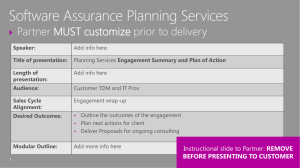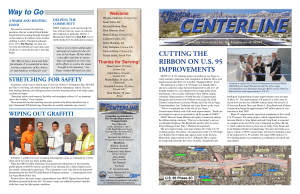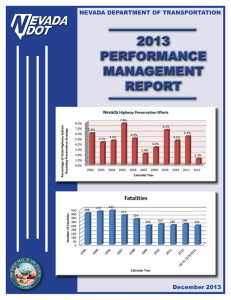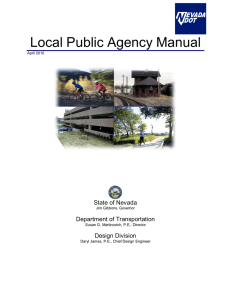NEVADA DEPARTMENT OF TRANSPORTATION
advertisement
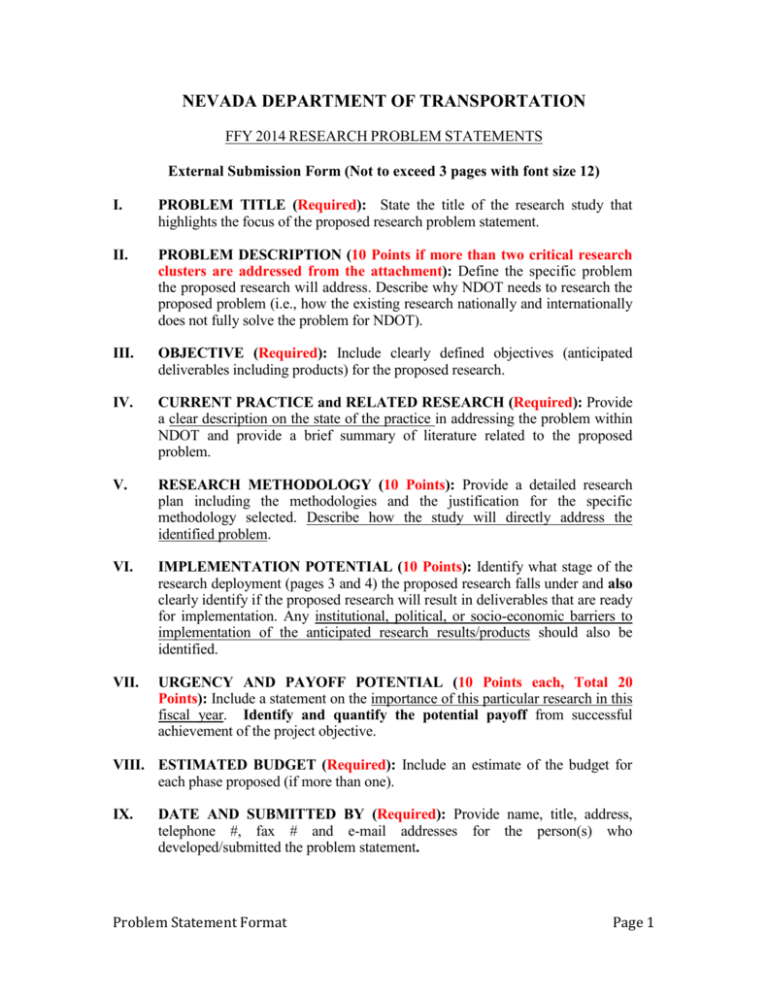
NEVADA DEPARTMENT OF TRANSPORTATION FFY 2014 RESEARCH PROBLEM STATEMENTS External Submission Form (Not to exceed 3 pages with font size 12) I. PROBLEM TITLE (Required): State the title of the research study that highlights the focus of the proposed research problem statement. II. PROBLEM DESCRIPTION (10 Points if more than two critical research clusters are addressed from the attachment): Define the specific problem the proposed research will address. Describe why NDOT needs to research the proposed problem (i.e., how the existing research nationally and internationally does not fully solve the problem for NDOT). III. OBJECTIVE (Required): Include clearly defined objectives (anticipated deliverables including products) for the proposed research. IV. CURRENT PRACTICE and RELATED RESEARCH (Required): Provide a clear description on the state of the practice in addressing the problem within NDOT and provide a brief summary of literature related to the proposed problem. V. RESEARCH METHODOLOGY (10 Points): Provide a detailed research plan including the methodologies and the justification for the specific methodology selected. Describe how the study will directly address the identified problem. VI. IMPLEMENTATION POTENTIAL (10 Points): Identify what stage of the research deployment (pages 3 and 4) the proposed research falls under and also clearly identify if the proposed research will result in deliverables that are ready for implementation. Any institutional, political, or socio-economic barriers to implementation of the anticipated research results/products should also be identified. VII. URGENCY AND PAYOFF POTENTIAL (10 Points each, Total 20 Points): Include a statement on the importance of this particular research in this fiscal year. Identify and quantify the potential payoff from successful achievement of the project objective. VIII. ESTIMATED BUDGET (Required): Include an estimate of the budget for each phase proposed (if more than one). IX. DATE AND SUBMITTED BY (Required): Provide name, title, address, telephone #, fax # and e-mail addresses for the person(s) who developed/submitted the problem statement. Problem Statement Format Page 1 X. NDOT CHAMPION, COORDINATION AND INVOLVEMENT (Required and Additional 10 points for multiple champions from more than one section): Identify the NDOT champion you have worked with to develop this problem statement. If possible, include a letter or email of support. Identify all Stakeholders including NDOT Sections/Divisions. Problem Statement Format Page 2 Five Stages of Research Deployment (Based on Caltrans Research and Innovation Stages) 1. Concept Stage (Stage I) First steps following Problem Statement and Proposal Development Includes detailed literature search Involves experimental design, data collection, analysis, and reporting Assesses results of research Defines barriers to implementation (e.g., policies, specifications, standards) Submits a Final Report and outlines a recommended implementation plan Includes collaboration with outside agencies or other state DOTs and US DOT (Applies to all Stages of Deployment) 2. Laboratory Prototype Stage (Stage II) Develops breadboard circuit or computer system modeling Demonstrates operation in laboratory setting May incorporate customized or one-of-a kind components Assesses results Submits Final Report and recommends design of full scale demonstration Potential end users are enlisted to support the field pilot stage 3. Controlled Field Demonstration Stage (Stage III) Prepares for full scale testing of demonstration project Controlled tests at specialized facilities are observed and supported by cooperating agencies, industry, and technical associations Potential end users are enlisted to support the field pilot stage Assesses results Problem Statement Format Page 3 Submits Final Report and recommends site/conditions for first application pilot stage 4. First Application (Contract) Field Pilot Stage (Stage IV) Works with potential end users to select site and to conduct pilot testing under real world operating conditions Test specifications and standards are developed Research assistance given to assure proper installation and operation Problems are corrected and adjustments made, as necessary, to complete pilot testing To the extent possible, potential end users operate the project under careful research surveillance Assesses results Submits Final Report and recommends initial sites for full corporate deployment Potential end users are enlisted to support the field pilot stage 5. Specification & Standards with Full Deployment Stage (Stage V) End users select site(s) and deploy the method/process/equipment using resident management, supervision, staff, and contracting forces (where applicable) Deployment is without research supervision or direction On call assistance is available upon request Assesses results Problem Statement Format Page 4

